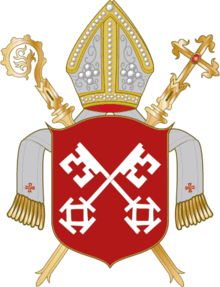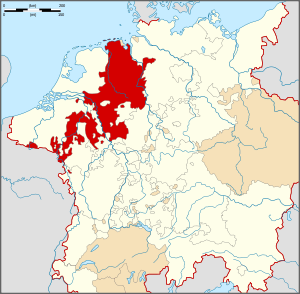Bishopric of Minden
| Prince-Bishopric of Minden | ||||||||||
| Hochstift Minden | ||||||||||
| State of the Holy Roman Empire | ||||||||||
| ||||||||||
| ||||||||||
.svg.png) Map of part of the Lower Rhenish–Westphalian Circle in 1560, Prince-Bishopric of Minden highlighted in red | ||||||||||
| Capital | Minden | |||||||||
| Languages | Northern Low Saxon | |||||||||
| Government | Principality | |||||||||
| Historical era | Middle Ages | |||||||||
| • | Founded by Charlemagne | 803 | ||||||||
| • | Gained Reichsfreiheit | 1180 | ||||||||
| • | Possessed Hamelin | 1259–77 | ||||||||
| • | Peace of Westphalia: Secularised to Brandenburg-Prussia |
1648 | ||||||||
| • | Ceded to Westphalia | 1807–14 | ||||||||
| ||||||||||
.jpg)
The Bishopric of Minden was a Roman Catholic diocese (German: Bistum Minden) and a state, Prince-bishopric of Minden (German: Hochstift Minden), of the Holy Roman Empire. Its capital was Minden which is in modern-day Germany.
History
The diocese was founded by Charlemagne in 803, after he had conquered the Saxons. It was subordinate to the Archbishopric-Electorate of Cologne. It became the Prince-Bishopric of Minden (German: Fürstbistum Minden) in 1180, when the Duchy of Saxony was dissolved. In the 16th century, the Protestant Reformation was starting to take hold in the state, under the influence of the Duchy of Brunswick-Lüneburg. Minden was occupied by Sweden in the Thirty Years' War, and was secularized. The Peace of Westphalia of 1648 gave it to the Margraviate of Brandenburg as the Principality of Minden (German: Fürstentum Minden).
Since 1719, Minden prince-bishopric was administered by Brandenburg-Prussia together with the adjacent County of Ravensberg as Minden-Ravensberg. In 1807, it became part of the Kingdom of Westphalia. In 1814, it returned to Prussia and became part of the Province of Westphalia.
As of 1789, the principality had an area of 1,100 km2 (420 sq mi). It was bordered by (clockwise from the north): an exclave of the Landgraviate of Hesse-Kassel (or Hesse-Cassel), the Electorate of Hanover, the County of Schaumburg-Lippe, another exclave of Hesse-Kassel, the Principality of Lippe, the County of Ravensberg, and the Prince-Bishopric of Osnabrück. Cities included Minden and Lübbecke.
As to the diocese of Minden, there was no legitimate Roman Catholic pontificate any more since the Swedish takeover in 1648. The diocesan area, comprising besides the temporal prince-bishopric also parts of Brunswick-Wolfenbüttel and all of Schaumburg-Lippe, was made the first defunct diocese taken care of by the Apostolic Vicariate of the Nordic Missions in 1667. Between 1709 and 1780 the former diocesan area formed part of the Vicariate Apostolic of Upper and Lower Saxony, before it was reincorporated into the Nordic Missions. In 1821 the former Minden diocesan area within the former prince-bishopric boundary became part of the Diocese of Paderborn, whereas the Brunswickian part became part of the Apostolic Vicariate of Anhalt and Brunswick in 1825, only to join the Diocese of Hildesheim in 1834. The Schaumburg-Lippe area stayed with the Nordic Missions until their dissolution in 1930, becoming first part of the Diocese of Osnabrück and then of Hildesheim as of 1965.
Famous bishops
- Saint Erkanbert (803–813)
- Saint Hardward (813–853)
- Saint Theoderich (853–880)
- Saint Thietmar (1185–1206)
- Francis of Waldeck (1530–53)
- Julius, Duke of Brunswick-Lüneburg (1553–54)
- Henry Julius, Duke of Brunswick-Lüneburg (1582–85, Protestant)
- Christian the Elder, Duke of Brunswick-Lüneburg (1599–1625, Protestant)
- Francis of Wartenberg (1631–48)
Auxiliary bishops
- Johann Christiani von Schleppegrell, O.S.A. (1428–1468)[1]
- Johannes Tideln, O.P. (1477–1501)[2]
- Johannes Gropengeter, O.S.A. (1499–1508)[3]
- Ludwig von Siegen, O.F.M. (1502–1508)[4]
- Heinrich von Hattingen, O. Carm. (1515–1519)[5]
See also
References
- ↑ "Bishop Johann Christiani von Schleppegrell, O.S.A." Catholic-Hierarchy.org. David M. Cheney. Retrieved March 21, 2016
- ↑ "Bishop Johannes Tideln, O.P. Catholic-Hierarchy.org. David M. Cheney. Retrieved March 21, 2016
- ↑ "Bishop Johannes Gropengeter, O.S.A. Catholic-Hierarchy.org. David M. Cheney. Retrieved July 28, 2016
- ↑ "Bishop Ludwig von Siegen, O.F.M." Catholic-Hierarchy.org. David M. Cheney. Retrieved March 21, 2016
- ↑ "Bishop Heinrich von Hattingen, O. Carm. Catholic-Hierarchy.org. David M. Cheney. Retrieved July 28, 2016
- At Meyers Konversationslexikon, 1888 (German)
- At NRW-Geschichte.de (with map) (German)
-
 Herbermann, Charles, ed. (1913). "Minden". Catholic Encyclopedia. New York: Robert Appleton Company.
Herbermann, Charles, ed. (1913). "Minden". Catholic Encyclopedia. New York: Robert Appleton Company.


